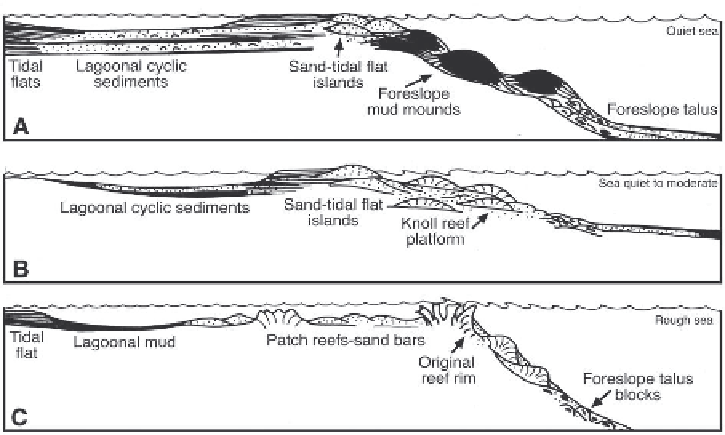Geology Reference
In-Depth Information
rimmed platforms (depositional slope). Downslope
sediment transport occurs predominantly via non-
channelized sheet flow. Carbonate slope sediments
extend without interruption from the basin along gentle
gradients (< 4°) up to a shallow platform margin.
• The existence of erosional slopes. Steep to vertical
escarpment walls can be formed during sea-level low-
stands and by tectonics. The upper part of these walls
may be settled by luxuriant reef-building communities.
The lower part of the cemented rock can exhibit ledges
and ridges acting as a base for sediment deposition and
the formation of microbially induced micrite crusts that
can also be recognized in ancient slopes (Brachert and
Dullo 1994).
• Incised parallel gullies, oriented perpendicular to the
platform margin, and formed by erosion associated with
downslope gravity flows. These gullies are a line source
of sediment supply from the platform and upper slope
to the lower slope.
• The angle between the platform margin and the slope
controlling the facies belts parallel to the platform
margin. Slope angles of modern slopes may be low (5°-
15°), but are often relatively high (<40°) and may even
be considerably steeper.
• Changes in dip from upper to lower slopes (steep-
ened in mid-slope or lower slope settings).
Platform-margin to slope transitions and facies pat-
terns of carbonate slopes:
Fig. 15.17 shows strati-
graphic profiles describing three generalized types of
buildup and geometry in Phanerozoic platform mar-
gins. Differences in the size, position and composition
of these margins are important for understanding depo-
sitional slopes because the sediments produced on the
platform and at the platform edge are the main source
for carbonate slopes. Types I and III correspond to
rimmed carbonate platforms, type II to a homoclinal
ramp. Note that Fig. 15.17 documents only the upper-
most parts of slopes adjacent to the platform-margins.
The composition of slope sediments
: Microfacies
studies are essential for understanding the composition
of slope sediments, differentiating allochthonous and
autochthonous material, and recognizing sediments
formed by specific depositional processes (e.g. turbid-
ites, debrites, slope breccias). Carbonate slope sedi-
ments consist of allochthonous and autochthonous sedi-
ments and include:
•
Allochthonous shallow-marine platform material
composed of mud- and sand-sized particles (disinte-
grated calcareous algae, various skeletal grains, bio-
erosional chips, peloids, composite grains), and sand-,
Fig. 15.17.
Basic types of platform margins
after Wilson (1974) distinguished by the stratigraphic profile, shape and position
of sand bars or different kinds of reefs along the profile slope, and diagnostic facies patterns. This classification calls particu-
lar attention to the geometry of rock bodies and is a useful approach in hydrocarbon and mineral exploration.
A:
Type I
(downslope mud accumulations)
is characterized by linear belts of downslope lime mud accumulations forming foreslope
mud mounds below the tidal wave base. Crestal deposits are sand bars or sand islands.
B:
Type II
((knoll reef ramps)
includes
linear ramps or non-rimmed platforms with patch reefs (knoll reefs), commonly formed on gentle slopes at the outer edges of
shelf margins. Bioclastic interreef material is much greater in volume than the patches of in-situ framework. Crestal deposits
are sand shoals, bars or mud flats behind the wide, gently sloping platform.
C:
Type III
(frame-built reef rims)
is a platform
margin created by an organic reef rim of resistant framework built into the active wave base and forming the topographic
crest of the profile. Types I and II appear to have been more common in the geological record than Type III.

